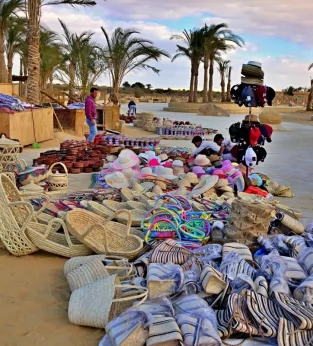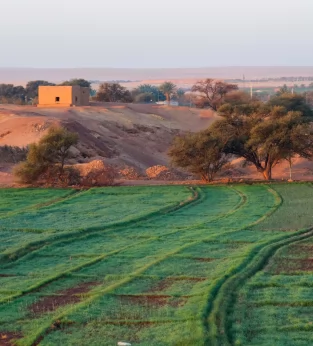Stay updated!
A visit to the temple of Alexander the Great, or to the mysteriously sounding Valley of the Golden Mummies are the main attractions that await tourists in the Baharija oasis. After visiting them, it is worth relaxing in the hot springs among the gardens full of flowers and fruit.
Bahariya is called the Northern Oasis. The depression in which it is located extends over an area of 4,000km2. The bottom of the valley is covered with palm groves and orchards. The inhabitants of the Bahariya oasis are an ethnic mix and both the original settlers and members of Bedouin tribes who decided to settle in one place, live here. Families from Middle Egypt also came here in search of a better life.
At the end of the 1950s, the oasis was inhabited by almost 6,000 people. Most of the young people then emigrated to the capital. The revitalization of the oasis, the construction of roads connecting it with the Nile Valley, Cairo and other oases, the opening of a mineral mine, as well as spectacular archaeological discoveries resulted in the development of tourism, and thus created new jobs. This resulted in more people wanting to live there and currently, the oasis is inhabited by over 30,000 people.
Bahariya oasis is surrounded by high hills, built mainly of quartzite and basalt, giving them their black color. It is worth going about 50km south of the oasis, where the Black Desert is located. There are millions of tiny black pebbles on the ground and the shape of numerous hills resembles truncated volcanic cones. About 60 million years ago, when the relief of this area was formed, they were probably islands protruding above the surface of the huge sea. This is very near a different type of natural miracle, the White Desert National Park, which is just about 20 miles away, known for its stunning chalk rock formations.
Bawiti
Bawiti is the capital of the Baharija oasis. The significance of the city was influenced by a spectacular find. In 2000, a necropolis from the Roman Period (1st century BC - 4th century AD) was discovered here, which was called the Valley of the Golden Mummies. It's estimated that over 10,000 people were buried there. The dry and hot climate contributed to the preservation of the tombs, and they remain in almost perfect condition, including gilded and painted coffins, golden death masks, valuable jewelry, amulets, as well as wine and oil jugs. A modest selection of these valuable monuments can be seen in the small museum in Bawiti.
Two richly decorated tombs in another necropolis, Qarat Qasr Salim, from the turn of the 7th and 6th centuries BC (about 400 meters north of the Museum of Golden Mummies) are noteworthy. They belonged to wealthy merchants and great landowners - father and son. The richness and importance of the people buried here are seen in the bas-reliefs depicting numerous gods, including Amon-Ra, Anubis and Horus. Only high-ranking royal officials and dignitaries could afford the company of the gods in their homes for eternity. Some of the ornaments of the magnificent tombs were destroyed a long time ago by thieves who decided to steal the local reliefs. However, they were recovered and can be seen today at the Egyptian Museum in Cairo.
Among the ancient ruins that are still visible in the streets of Bawiti, the aqueduct system is impressive. They run almost 3 km through the city. They come from the heyday of the oasis (7th-6th centuries BC), and were still in use at the beginning of the 20th century.
El Qasr
El Qasr is the modern name of Psobtis, the ancient oasis capital of Baharija. The most interesting object in the city is the Ain Al Muftella temple. In antiquity, city life concentrated around the temple. It was built during the reign of King Amasis (6th century BC) and its architecture is unusual. The building consists of four separate chapels with reliefs on all walls depicting religious scenes. In the chapel marked with the number three, you can see a rare image of the god Bes, the patron saint of dance and joy, and at the same time a protective house deity. He was worshiped primarily in homes and special altars were erected for him there. The remaining chapels are decorated with images of the lord of the underworld, Osiris, and various deities participating in the procession.
Also in the 6th century BC, a chapel dedicated to King Apries was erected at EL Qasr. His name was written on one of the walls. There are remains of another temple near the sanctuary. It was dedicated to Bes, as evidenced by the items found inside, including a statue of the deity measuring over 1.3 meters (now on show in the Egyptian Museum).
Temple of Alexander the Great
Near Bawiti, there is one temple in the Western Desert that's dedicated to Alexander the Great. Erected in the 4th century BC, it commemorates the visit of the Macedonian leader to the Oracle of Amun in Aghurmi in the Siwa oasis. It is one of the few places in Egypt where a relief and cartouche of this ruler have been found. The main structure of the temple consists of only two rooms. Several dozen years have passed since the temple was discovered, and most of the frescoes and reliefs exposed to the sun and wind have been destroyed. The items saved can be seen in the Egyptian Museum in Cairo. The surviving monuments include the red granite altar. It once stood in front of the temple and bears the name of Alexander.
The brick ruins around the sanctuary are the remains of houses and warehouses. The buildings were owned by priests and officials who managed the facility. Numerous coins, small amulets, everyday objects and ostracons (limestone or ceramic fragments on which various information were written, in this case in Coptic and Greek) have been found - all of these can be seen in the New Valley Museum in Kharga.
Ready to start your adventure in Egypt? Book your Egypt tour package!









